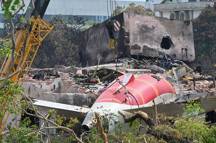The sole survivor of the Air India plane crash that claimed 260 lives is reportedly living a life of torment since the crash.
Flight AI171 was en route to Gatwick Airport in London on June 12 when it crashed into a hostel housing medical staff from the Byramjee Jeejeebhoy Medical College, less than a minute after takeoff.
The aircraft climbed to just 625 feet before it lost location data 50 seconds after takeoff.

British national Vishwash Kumar Ramesh, 40, was seated in 11A when the Boeing 787-8 Dreamliner plummeted just seconds after takeoff from Ahmedabad, killing 260 people, including 19 on the ground.
He walked away with facial cuts and chest injuries, but the emotional toll is ongoing.
“He can’t sleep at night,” his nephew, Krunal Keshave, told The Sunday Times. “He sleeps but doesn’t sleep properly. When he sleeps, he dreams he is on the flight. He remembers seeing everyone die in front of his eyes.”
Ramesh, who now remains in India with his wife and four-year-old son, is reportedly suffering from survivor’s guilt and intense grief over the loss of his younger brother, Ajay, 35, who perished in the crash.
The two siblings had run a fishing business together and were preparing to return to their UK homes after the season ended.
“He sees him (Ajay) everywhere,” said Keshave. “He speaks but he doesn’t speak about the crash. His wife and his son… are there with him, supporting him. He is trying to have a normal life, but he is not going out too much. He is spending time at home with the family.”
Another relative added: “He feels guilty that he is the only one to have lived when everybody else, including his brother, died. It’s a lot to live with.”
Ramesh had escaped through the emergency exit and was hailed as the “miracle man” and “God’s child” by locals. Reflecting on the horror, he said: “I don’t know how I came out of it alive. I saw people dying in front of my eyes.”
Now, investigators are zeroing in on what may have triggered the catastrophe.
A 15-page preliminary report by India’s Aircraft Accident Investigation Bureau (AAIB) reveals that both of the aircraft’s engine fuel-control switches were flipped from “RUN” to “CUTOFF” just seconds after liftoff – instantly severing fuel to the engines.
The cockpit voice recorder captured one pilot asking: “Why did you do the cut-off?” to which the other responded: “I didn’t.”
Clive Kunder, 32, was flying the plane while Captain Sumeet Sabharwal, 56, was monitoring. US officials believe it was Sabharwal who activated the fuel switch, though investigations are ongoing.
Aviation experts say the act could not have been accidental. “They require absolute physical effort to lift the switch up, raise it over … and back down,” Captain Byron Bailey told Sky News.
“So it had to be done by one of the pilots. Three seconds after lift off is the perfect time to have done this.”
The AAIB timeline shows the aircraft reached 180 knots at 08:08:42 UTC. Just seconds later, the engines lost power.
Speculation about a deliberate act was quickly condemned, per News.com.au.
“There is absolutely no basis for such a claim at this stage,” said the Indian Commercial Pilots Association. “It is deeply insensitive to the individuals and families involved.
“To casually suggest pilot suicide without verified evidence is a gross violation of ethical reporting and a disservice to the dignity of the profession.”